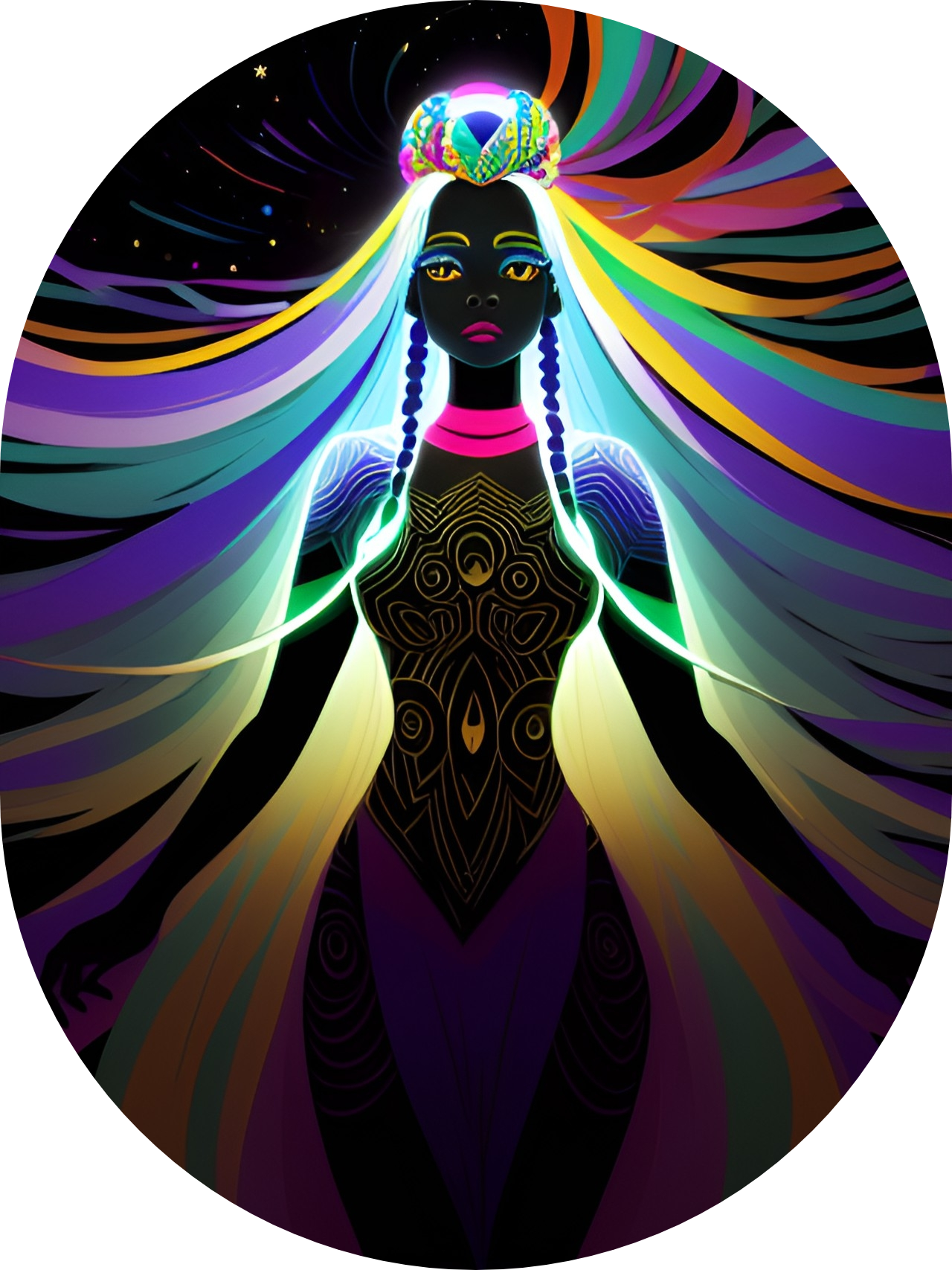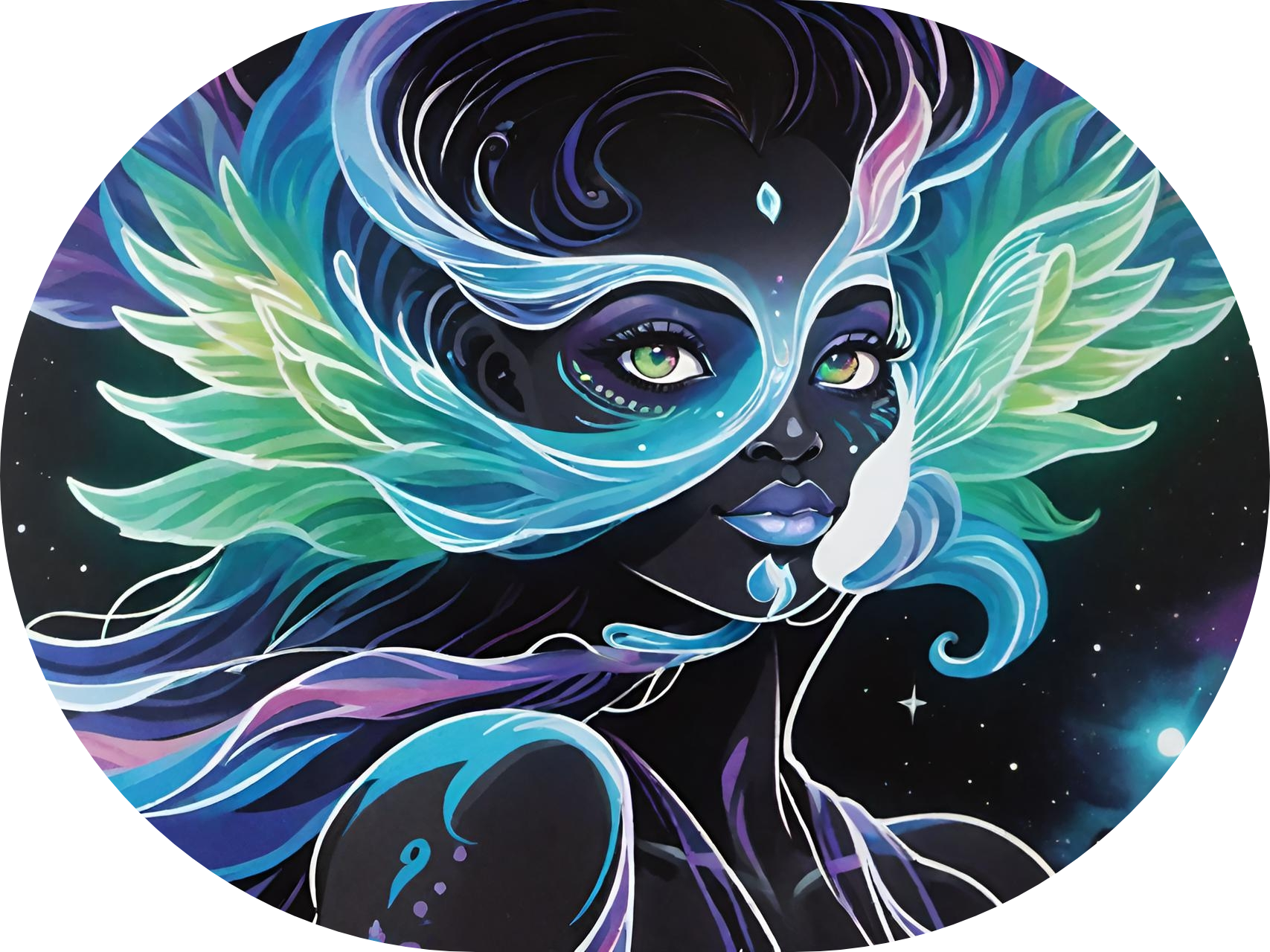Kalitho
the Colorful
Kalitho is the embodiment of color, of all electromagnetic waves on the spectrum! She is an aspect of Lithmor, the Erlithmanil of Light, a physical aspect which exists within Kalitho's Plane. She embodies color and electromagnetic waves including radiowaves, microwaves, infrared, ultraviolet, x-rays and gamma rays. However, this aspect revolves around the waves themselves and not the radiant energy or ionization they may produce. Those fall instead under Rithaldis. Azowyr, an aspect of Zalikar, is Kalitho's counterpart.
Outside her literal role as the embodiment of visible light, Kalitho is associated with a number of other concepts she is seen as the goddess of. These include beauty, art and fashion, magical illusions and performances, rainbows, purity, grace, love and eternal youth! Alongside aspects like , Sonildaz, Emryl and Martor, Kalitho is a patron of the arts and creativity, totally enamored with the creations of humanity. For this reason, she is one of the most beloved elementals, hiding the harsher and more judgemental of her qualities! |
Kaithur |
During the Era of Legends, the Erlithmanil blessed residents of Emynea with their magic. Passed down from parent to child, they came to call these gifts Kaithur. Over time, every lifeform on Emynea came to inherit two of these blessings. Kaithur are named by the aspect a caster is connected to and by how they can wield it--how they manifest their connection.
Color magic is very common in Emynea and can be found in every corner of the globe! However, it is most concentrated in Alkelbulan, especially Birit Narim and Nyasi za Rangi. Additionally, those born with color magic tend to develop certain personality quirks or tendencies matching Kalitho herself! |
Known Manifestations
This is the simplified explanation of these abilities. See Mental Manifestations for more details, limits and functions.
Manipulation |
Aura |
|---|---|
Those born with Kalitho's Manipulation are able to controland reshape light present in their environment. This can be used to craft intricate illusions, change the appearance of the world around them and even alter the visual perceptions of those around them! |
Casters of Kalitho's Aura are able to summon or generate light in a variety of ways, creating any illusion they can imagine! They can emanate certain colors, produce blinding flashes or, with practice, even alter thier own appearance. |
Movement |
Slip |
Those with Kalitho's Movement are able to walk, step or move on bright or colorful lights which become a solid foothold for them. They can also briefly transform into rainbows, travel at the speed of light or merge with vivid colors in their environment before reverting back. Sometimes, this allows them to pass through certain materials such as glass. However, shadow magic can harm them in this state! |
When activated, their body of those with Kalitho's Slip will automatically transform into a kind of light or even a rainbow when touched, interacting with physical mattter similarly to light. Most materials pass right through them! Their body will immediately transform back once the foreign object has been removed, this transformation automatic. They can also pass through objects which light can pass through such as glass!. |
Eye |
Sense |
Those with Kalitho's Eye are able to see and see using every kind of light on the electromagnetic spectrum! They can cycle between different forms of light, perceiving the world in infrared and x-ray. They are also unbothered by bright lights. |
Casters with Kalitho's Sense are able to feel their environment using light, feel anything interacting with light and sense light in their environment despite barriers. |
Skin |
Touch |
Casters using Kalitho's Skin can emit light from their skin, controlling colors and patterns freely. Skilled casters can even imitate the appearance of their surroundings, gaining a potent camouflage! |
Kalitho's enables a caster to temporarily alter the natural color of anything they touch, altering which light is getting absorbed or reflected and lacking objects with illusions. This can be small differences or grand illusions changing not just their color but their entire appearance! |
Craft |
Will |
Those inheriting Kalitho's Craft can permanantly alter the color and appearane of anything they touch, altering which light is getting absorbed or reflected. Essentially, they can weave permanent illusions into matter. They can mold this in great detail and, with enhancement, on large scales. Whether tweaking appearances with illusions or dying materials by hand, they are essentially artists painting on a canvas. And only they can reverse the effect! |
Casters with Kalitho's Will can boost or enhance the magic of others by using light and color as a bridge! They cast their magic into mediums such as paint or shining colorful lights onto allies, boosting their abilities upon contact. |
Imprint |
Shield |
A caster with Kalitho's Imprint can imprint on a given number of people, marking or unmarking targets by touch with their own personal sigil. Once placed, the caster can sense the location and status of those marked. When activated, a rainbow links them to those marked by their imprint. No matter how far they travel, the caster can always find them!. |
Kalitho's Shield renders casters immune to all color magic, unbothered by negative effects or damage from all kinds of light magic and naturally occurring lights. They are also impervious to illusions, naturally seeing past illusiory deceptions.
|
Vision |
Step |
Those inheriting Kalitho's Vision can enter a meditative state, exploring and peeking through portals within Kalitho's Plane. They leave their physical body behind, mentally exploring the plane in the form of a hologram. |
Casters with Kalitho's Step can enter and exit Kalitho's Plane via portals and travel the plane freely, without injury or impediment. They can also bring others with them while maintaining contact. Portals into the color plane are instances of bright lights, rainbows and bright colors! |
Form |
Body |
Casters born with Kalitho's Form can convert parts of their body into electromagnetic light or has light incorporated into their form. Their limbs or hair or whatever else transform into seeming holograms, materials passing through them harmlessly or interacting with them as light would such as glittering through water or glass. Others may gain a shroud, wings, cloak or armor of prismatic colors! Each individual looks a little different. |
Those born with the rare ability Kalitho's Body can convert their entire body into electromagnetic light. Considered the ultimate manifestation of color magic, these casters gain abilities similar to those with Aura, Eye, Movement, Slip and Shield! Even beyond their transformation, these casters can fully merge with bright lights and vivid colors, leaving their human shape behind before reforming elsewhere. However, these abilites quickly eat up energy and those who aren't Divine Descendant may not be able to use all of these abilities. |
Appearance |
Kalitho in her natural state consists purely of electromagnetic waves, her body comprised of visible light. In fact, she is capable of taking on any visible appearance she chooses, human or otherwise! She almost resembles a hologram but when she needs to, she can take on a fleshy, humanoid form. Much like Lithmor, Kalitho prefers characteristics of an Alkelbulian woman where the majority of her followers reside. However, Kalitho is willing to alter her racial characteristics more than her sisters are. Kalitho is an entity that values beauty above all other things, taking on whatever styles and clothing and features are considered the most beautiful at the time! And unlike her sisters, Kalitho more often takes on a thinner physique, especially in eras wherin thin is prized as beautiful. Otherwise, Kalitho's white hair is dyed in an array of colors, even more lurid than her clothing. Her style is brilliant, extravagant, bold and expressive--some might even call it gaudy but she has a talent in making anything look good! |
Abilities |
Kalitho is the physical and mental expression of visible light within the real world. They are all a part of her, an extension of her and her power. She can freely manipulate and utilize light as if commanding her own limbs. However, without a physical body her influence over the physical world is limited. While she has total control over her plane, there is only so much she can affect in the outside world. She can reach through strong portals and bend lights to some extent but even these are mere illusions. Despite this, she can still view the world through windows and portals and all color magic still pulls from her as their source. |
Mythology |
As has been ascribed many identities through mythology, she also has come to be represented by an array of plants and animals! Most of these creatures are her favorite species from across Emynea while others she grudgingly accepts for the sake of her followers. |
Aphrodite
Hellenes goddess of sexual love, beauty, pleasure, procreation., she is one of the main Olympian gods. Supposedly, she was born from sea foam created from the castration of Kronus by Zeus while in other legends she is the daughter of Zeus. She went on to marry Hephaestus and have several children including Eros. Aphrodite is most venerated in Cyprus, Corinth and Athens, going by the name Venus in Quiris mythology.
Beyond her role in the arts and her role as the goddess of beauty and love, Aphrodite is also the guardian of sea travel, courtesans and prostitutes. Most often she is depicted nude, especially in sculptures and murals. Her symbols include seashells, myrtle, apple, cinnamon, balsam, scallop shells, mirror, roses, doves, sparrows and swans and she features in many legends. These legends usually involve contests of beauty and their brutal consequences, love affairs with other gods or even human men or legends involving her children--there is even a legend of her animating a sculpture whose artist had fallen in love with! |
Charite Aglaea
The Charites, also known as the Graces, are Hellenes goddesses who personify beauty and grace. Each of these Graces is believed to be a different aspect of the gods, especially those of Lithmor, and some complex aspects are split further into different graces. Three of the most famous Charites are Aglaea, Euphrosyne and Thalia, daughters of Zues and Eurynome (daughter of Oceanus). Kalitho is equated as Aglaea, the grace of splendor and beauty. In myth, Charites attend to other gods during festivities, especially Aphrodite and Hera. Charites are normally depicted naked, dancing very closely or in a line. |
Cliodhna
Cliodhna, also known as Clidna, Clionadh, Cliodna, Cliona or Cleena, is the Daoine and Angli goddess of love, beauty and fertility. Cliodna is fairy woman (sidhe), more specifically a banshee (sioga). In fact, she is the queen of banshees and queen of all of the Tuatha de Danaan! Her father was fabled to be Manannan Mac Lir, a sea god who is fond of her. She is a beloved goddess who protects crops against blight, protects cattle and defends against both disease and the evil eye! Several dynasties had claim to have Cliodna's patronage if not claiming her as their matron. These include clans such as MacCarthy, FitzGerald, O'Donovan, O'Collin, O'Keeffe and the O'Learys. The most famous is perhaps Domhnall O'Donovan known as the Dragon of Cliodhna.
Cliodna is known to have her own personal fairy mound, Carrigcleena or Cleena's Rock, which acts as a sacred space for her followers and an entrance to her realm in the Otherworld (for those who know how to access it). This door to the Otherworld is sacred not just to the Daoine but to local Angli as well who see light aspects as their benefactors. Carrigcleena encompasses a circular area of 2 acres partitioned by rocks which are 20 feet tall. It conceals a series of caves and a structure resembling a massive door along the southern edge, believed to be a door into the Otherworld. Once, these grounds were a place of joy, beauty and delight but now it is lonesome, bittersweet and eerie. Supposedly, Cliodna and her banshees dance once a month under the waxing moon and she used to comb her hair atop her carraig just before sunrise. Cliodna would dance as well, standing out in her stunning and prismatic attire. It is likely that Kalitho would interact with her followers regularly using this site but, with Lithmor sealed away, it has all but fallen into ruin. She is also fabled to have three colorful birds which eat apples from otherworldly trees! They consume these magic apples from Otherworld realms including Tir na nOg (Land of the Young), Tir Tairngire (Land of Promise) and Mach Meall (Pleasant Plane). Thanks to these apples, their song can cure almost any illness! Listeners fall into a deep sleep which heals wounds and sickness. Having a strong association with birds, Cliodna herself was able to transform into wrens or white hares. As queen of the banshees, Cliodnaand her sisters were responsible for forewarning the death amid the most ancient families of the Chain. Their bone-chilling shreeks sound as Cliona or her banshees depart the Otherworld, ablex to see the shadow of death stretching over the decendants of her worshippers! But she is equally feared as she is revered, known for kidnapping attractive men or leading them to an early grave in the same place her mortal body died--a cliff she journeyed to in her pursuit of Ciabhann of the Curling Locks. Her father grew jealous of her love for him, sending his own bard Iuchna to lull her to sleep where he sent a wave to drown her. Before her downfall, currently equated to Lithmor's downfall, she prophesized another terrible wave would one day swallow the city she had once been a patron to, a wave called Tonn Cliona (Cliona's Tide). For this reason, women on the shore as a ship departs is still considered a bad omen. Perhaps the most famous legend involving Cliodna involves the other patrons of her city, Aoibhell and Aine. Cliodna had a rivalry with Aoibhell, both goddesses falling in love with a human chieftan, O'Caoimh. Initially, O'Caoimh had chosen Aoibhell and had even proposed to her! In desperation, Cliodna sought the guidance of an old wise woman, a dark mage whose spell caused Aoibhell to begin to fade away. Cliodna offers Aoibhell a cure with the condition that she renounces her engagement but Aoibhell refuses to do so. Neither woman wavering, Cliodna instead uses a magic wand to turn Aoibhell into a white cat! With his fiance missing, the chieftan marries Cliodna instead. But eventually, the old mage confesses to O'Caoimh and gives him the wand. The chieftain turns Cliodna into a cat and restores Aoibhell in one swoop! |
Freyja
Freyja is a goddess of many names, a figure in the myths of both Skaney and several cultures of the Eluzian Valley. Some of these names and their meanings includde Freya (Lady), Gefn (Giver), Horn (Flax), Mardoll (Sea-Brightness), Syr (Sow), Vanadis and Valfreyja. She is widely worsphipped goddes in Eluziar, acting as the goddess of fertility, love, beauty, war, magic, sex, wealth and youth. She is the bringer of dawn, the shining sun and healing hands--a renewer, protector, teacher, restorer, guide, confidant. She is a mother of magic, a sorceress, a seer and a high preistess. She is also the sister of Freyr, both of their names meaning Lady and Lord, and are the offspring of the god of the sea, Njord. Her husband is Odr, possibly a variant of Odhinn, and she has two daughters Gersimi and Hnoss.
Freyja is a mother goddess, a member of the Vanir tribe of the gods, but he husband is often gone. She is famous for her longing and sorrow for his absence, crying golden tears and sometimes taking up disguises to find him. It is also Freyja who taught the Aesir tribe of the gods witchcraft, Freyja herself being a seidr, a strong mage and diviner of fate--even Odr seeks her guidance in such matters! She resides in her sacred realm, Folkvangr, where half of all warriors reside in her sacred meadows (the rest going to her husband Odr's hall instead). In this way she is both a goddess of beauty and love but also a goddess of war and death, a powerful and desireable figure! |
As a multifasceted goddess, Freyja is both revered and feared, especially by outside cultures which view her as an evil or tricky sorceress--and instigator of strife. Within her faith, she is a peacemaker but she also goads indecisive figures into action however brutally, pushing them into resolve and often in pursuit of revenge. To outsiders, she defies gender roles in a way that is transgressive and horrifying! She is sexually prolific in equal measure to the men in her pantheon and she incites agression between kings and warriors--all unwomanly behaviors to nearby patriarchal societies. But she thrives in this light, challenging women to be strong and to push themselves, to be independant and proud. She defies all attempts to subdue her, being burnt alive alive as a sorceress three separate times only to rise and be reborn each time!
Freyja is often depicted riding a boar with golden bristles, crafted by the dwarves of Skaney and named Hildisvin or "Battle Swine". Alternately, she might be protrayed travelling in a chariot or wagon pulled by two cats. She also owns a cloak made from falcon feathers and a grand necklace caled Brisingamen. Some depictions have her holding a staff or sceptor as well and her worshippers often wear boar masks and carry shields. For these reasons, her symbols include cats, pigs and boars, necklaces, pendants, apples and gold. She is believed to reside in Folkvangr (army-plain) and within her great hall Sessrumnir (roomy-seated). Both half of warriors who fell in battle reside in her hall but it is also a place which women can go afterr death! |
She remembers the battle,
the first in the world,
when they studded Gullveig with spears
and burned her in the high one's hall,
three times they burned her,
three times she was born,
often, not seldom, ye she still lives
They called her Heiðr
when she came to houses,
the deceitful seeress,
she worked her magic,
cast seiðr where she could,
caste seiðr on entranced minds,
ever was she a delight to wicked wives.
the Frowe
You lead the dance among the witches,
and bring the people joy and riches.
Radiant Lady, ever dear,
Freyja, hasten to us here!
Holda and Frigga
Considered another face of the goddess Freyja is the Deutsch and Ostmen goddesses of beauty and love. Frigg is the wife of Odin, the queen of the Aesir and mother of Baldur. She is the goddess residing over marriage, motherhood, fertility, family and fate. A heavy influence in Eluziar, her namesake is still used for the day of the week Friday, Frigg-Day. Much like Freyja, Frigg has the power of divination, foresight and prophecy. Holda especially resides over the hearth and the home, a protective deity of the houshold. She is associated with spinning and weaving of cloth, an act which symbolizes her weaving of fate and destiny.
Unlike Frejyr, Holda and Frigg are seen more as mediators of conflict rather than being the one to incite it. She is also a paragon of motherhood, doing all she could to protect her son Baldur when she foresaw his ill fate. She begged each and every thing in the world not to harm her son. So imperveous was Baldur to damage that the other gods made a game of throwing things at him knowing he wouldn't get hurt. But Frigg had overlooked one small plant she thought too harmless to possibly hurt him: mistletoe. Loki took advantage of this oversight, making a dart out of mistletoe. He gave this to Baldur's blind twin Hodur and "aided" him so he could join in on the game. This dart pierced Baldur's heart, killing this solar deity. Frigg had also begged for her son to be revived, but one entity refused and Baldur's fate was sealed. |
Iris
Iris is the Hellenes goddess of the rainbow if not the embodiment of the rainbow. She is most associated with communication, messages and new endeavours. Some see her as a goddess which fulfills humans' prayers, doing so herself or delivering them to other deities. Iris is the daughter of the sea god Thaumas and the ocean nymph Electra while her Quiris counterpart Arcus is the consort of Zephryus (god of the west wind) and mother of Pothos. She plays a similar role to Hermes as a messenger of the gods only she is often the personal messenger of Hera. The rainbow itself is her bridge and her road which lets her travel between the realm of the gods and the human world, Iris herself a symbol of purity as a virgin goddess. Otherwise, Iris acts as an attendant for Hera.
In legend, Iris had a sister Arke but while Iris sided with the Olympians amid their war Arke had sided with the Titans as their messenger. After the Titans were defeated, Arke's wings were torn from her body and eventually went on to be worn on Achilles' feet (his name meaning "feet like the wings of Arke"). |
Iris is depicted as a beautiful maiden with wings on her shoulders, carrying a caedecus staff or a vase. Sometimes she can be seen in art serving wine to the gods or escorting them to important events. She might even wear a splenid coat with many colors, this cloak creating the rainbows she rides from place to place! And her wings are so beautiful they can light up even a dark cavern. |
Zorya
Amid the many peoples living within the Eluzian Valley, reverence for the goddess of dawn is commonplace. According to their mythology, Zorya is the sister of the sun, the moon and the morning star, living within the Palace of the Sun and opening the gates for them each day. She is a virgin goddess and guards the Sun's white horses as he journeys through the sky. Alternate versions of this goddess include Prende, Ushas, Aurora, Eostre, Eos, Ausra and most of all Haeusos, spanning cultures across Eluziar and parts of Yaxiya. She is one of the most worshipped entities. She is protrayed as the daughter of the sky God, otherwise known as Dyeus, Zeus, Dievas or Zojz among others. Most of the time, these goddesses are equated to Kalitho but may instead represent Rithaldis or Sylthari.
These dawn goddesses are usually depicted as ageless, constantly reborn as the sun is reborn each day. She is also beautiful, often brilliantly beautiful as she is the "bringer of light". As such, colors representing these goddesses are gold, saffron, red or even crimson. Haeusos is depicted wearing clothes which are woven out of gold threads or golden shoes while Eos and Ushas wear saffron or crimson colored robes with a golden veil. Zorya herself is a "red maiden" sitting in a gold chairor on a white stone and holding a silver mirror. She weaves a red shroud over the sky using a golden needle, her beautiful golden hair marking her as a queen of a golden kingdom. |
Ayida-Weddo
This entity is a well-known loa, a spirit, in the faiths of many Alkelbulian tribes! Also known as Ayida, Agidab, Aido Quedo and Aido Hwedo. These faiths are especially common along the eastern coasts and islands of Alkelbulan. Ayida is known as the Rainbow Serpent, a spirit of fertility, rainbows, wind, water, fire, wealth, thunder and snakes. She is seen as one of the most important and oldest of loa and is even believed to have aided the creator goddess Mawu-Lisa when forming the world, Ayida herself connecting the earth and the heavens. In the form of the rainbow snake, she keeps the world from falling into the abyss and even transported to first humans from the heavens to the earth. She offers love and wellbeing to her followers, promoting fluidity and the connection of body and spirit. |
Ayida belongs to the Rada loa which are connected to protection, benevolence and love. Some view her as the source of the female half of Damballa, sharing a dual spirit. In other legends, Ayida is the wife of Damballa instead, sharing him with his mistress Ezulie Freda. Either way, when together they represent dynamism, life, creation and harmony between male and female, heaven and earth and body and spirit. Ayida is most associated with symbols such as the rainbow, snakes and thunderbolts. Sometimes this rainbow serpent is eating its own tail, becoming an ouraborous. In ritual veves, she is portrayed as dancing alongside Damballa, intertwined with one or two snakes. White is the color most associated with Ayida-Weddo, representing her in ceremonies as a color of purity. Her followers offer her white chickens, white eggs, cotton, rice and milk among other white offerings which are decorated with rainbows. |
Ochumare
The Oyo Yoruba people revere a goddess called Ochumare, also called Osumare, Orisha, Oshumare or Osunmare. She is a goddess which links together Emynea and the rest of the universe and is a supreme source of power. She is blissful and beautiful but she is also pure and proud. She is usually portrayed as a nude black goddess who sits on cosmic lily pads atop the waters of the Universe. A rainbow stretches between her hands and the earth spins in her lap, its spinning fueled by her own cosmic power.
In most legends, Ochumare is female but there are those who view her as androgynous or even transgender! She is seen as constantly transitioning from female to male and male to female, her gender flowing like a river. She is most often symbolized by snakes and rainbows and she is seen as a guardian of children. Other qualities of Oshumare are continuity, balance, permanance and transition.
|
Xochiquetzal
Those peoples descending from the original Mexica empire still maintain their old faiths, on whatever scale they can manage. Amid their pantheon is Xochiquetzal, the goddess of beauty, love, flowers, fertility and household arts and sometimes pleasure, weaving and embroidery. She is a protector of young mothers, presiding over pregnancy and childbirth. Sometimes she is viewed as human desire, pleasure, luxury and excess. Her name means "Precious Feather Flower" or "Flower Quetzal Feather" or she may go by the name Ichpochtli meaning "maiden" or other variations like Xochiquetzalli, Xochitl and Macuixochiquetzalli
Xochiquetzal is usually depicted as a young woman decorated by flowers and luxurious clothing, representing her beauty. She is believed to herald from a Tamoanchan, a vibrant paradise. She is the wife of Tlaloc (a rain god) but was abducted by Tezcatlipoca (god of the night sky) who made her into the goddess of love. While she is most associated with the aspect Kalitho, she sometimes represents Sylthari or Lithyr instead thanks to her association with the moon and flowers. A festival called Hueypachtli was held every eight years honoring her and Tlaloc. Her worshippers would make offerings of flowers and would honor her by wearing flower or animal masksn, drinking and even through sex rituals. One woman was chosen to be a ixiptlatli, impersonating Xochiquetzal--a highly respected but dangeorus postion. The ixiptlatli was decapitated and flayed, her skin woven and worn by a chosen man. |
Devi
Tenshodaijin
Brigit
Symbols of Kalitho |
|---|
Animals
|
Plants
|
Objects
Natural | Man Made |
|---|---|
Seashells, Scallop Shells, Jade, Gold, Pearl, White Diamond | Mirrors, Kaleidoscope, Fleur-de-lis, λ (Lambda) |





























Comments